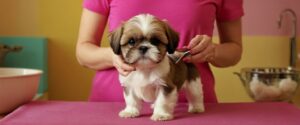Find out all about the Shih-Tzu dog breed from Adoption tips, grooming, feeding, toys, health care, and training tips.
Why the Shih-Tzu Dog Breed is So Popular in India
Few breeds of dogs have won hearts all over the world as much as the Shih-Tzu. This adorable toy breed, nicknamed the “Lion Dog,” is renowned for its sparkling eyes, silky coat, and temperament. What makes them endearing is their flexibility. A Shih-Tzu can be content relaxing in an urban apartment or romping in a suburban yard.
Shih-Tzus are more than an eye can meet. They have been companions to emperors, royalty, and families for centuries. They’re adored not for their labor but for their affection and warmth. The Shih Tzu canine breed is unlike some small breeds that are too boisterous or skittish. They are gentle, affectionate, and like to be around their people.
Some of the reasons why people fall in love with Shih-Tzus:
- Affectionate temperament – They adore being lap dogs and need human interaction.
- Flexible lifestyle – Suitable for both apartments and larger properties.
- Limited exercise requirements – The occasional short walk and indoor play are all that’s needed.
- Low prey drive – They generally coexist well with other animals.
- Family-oriented – Friendly with children if well socialized.
Due to their compact size, Shih-Tzus are simpler to take care of than larger breeds. However, even though they are small, they tend to stride confidently along with an air of authority — as royalty walking into a room.
History & Origins
One of the world’s oldest and most legendary breeds of dog, the Shih-Tzu has origins going back more than 1,000 years. Its past is inextricably linked with royalty, spirituality, and centuries of selective breeding.
Ancient Origins in Tibet and China
The initial ancestors of the Shih-Tzu were probably from Tibet. Monks bred small companion dogs and presented them as presents to Chinese emperors. Upon arriving in China, these dogs were further cultivated through breeding with the tiny Pekingese and Lhasa Apso breeds. The outcome was the Shih-Tzu we know today.
Companions of Chinese Emperors
Shih-Tzus during the Ming and Qing Dynasties had a luxurious life within the Forbidden City. They were indulgent lap dogs, loved by emperors and empresses. They weren’t bred for hunting, guarding, or herding — but merely as companions and comfort companions.
- They were frequently carried in silk sleeves or permitted to rest on royal pillows.
- Historical accounts present them as cherished pets of Dowager Empress Cixi, who loved their imperial looks.
Arrival in the Western World
Shih-Tzus were kept exclusive to Chinese royalty and unavailable to the outside world for centuries. The breed traveled to Europe only in the 1930s.
British diplomats and soldiers deployed in China took some of these canines back home. From there, the Shih-Tzu dog breed soon became popular in the UK and eventually in the United States.
The American Kennel Club (AKC) admitted the breed in 1969. The Shih-Tzu has ever since been one of the world’s favorite toy breeds.
A Legacy of Companionship
Unlike most breeds of dogs that were designed to work, the Shih-Tzu was always intended for friendship. That is why they’re so human-oriented and do best when they’re near their families.
Shih-Tzu Appearance and Personality

The Shih-Tzu has been called a big dog in a small body. Their beautiful appearance, combined with their outgoing and loving personality, has made them one of the most popular companion dogs.
Appearance
Shih-Tzus are a toy breed and are normally 9 to 16 pounds. They are sturdy, compact dogs despite their size.
Key physical features include:
- Head – Broad, with a short muzzle and a slightly undershot bite (giving them a sweet, “smushed” face).
- Eyes – Large, round, and dark, full of expression. Some lighter-coated Shih-Tzus may have amber eyes.
- Ears – Drooping, heavily feathered, blending into their luxurious coat.
- Coat – The coat is long, flowing, and silky. It comes in many colors: gold, white, black, brindle, liver, silver, and more combinations.
- Tail – Heavily plumed and curls over the back, adding to their regal stance.
Due to their long coat, Shih-Tzus usually resemble small lions or even little dolls. While some owners like having their coat long and flowing, others choose a “puppy cut” (shorter trim) for convenience.
Personality
What actually sets the Shih-Tzu apart is its lovely temperament. Where other small dogs might be nervous or too yappy, Shih-Tzus are more likely to be relaxed, loving, and confident.
Common personality traits are:
- Affectionate – They are lap dogs and adore people.
- Playful – Not hyperactive, but they play for a little while and with toys.
- Adaptable – Great for apartments, homes, or even homes with other animals.
- Social – Friendly towards strangers, children, and other animals if socialized early.
- Alert but not aggressive – They’ll bark to alert someone at the door, but they’re hardly
- Watchdog aggressive – They may bark when someone comes to the door, but they’re rarely watchdog material.
Temperament at Home
- With Children: Shih-Tzus are wonderful with children if treated gently. They are stronger than a few of the toy breeds, so they would be a better pick for families.
- With Other Pets: They coexist quite well with cats and other dogs, provided they are introduced early.
- With Seniors: They don’t require much exercise, making them a great fit for older adults who would love to have a personal companion.
Briefly, the Shih-Tzu is a companion dog. They are here to love, enjoy family where they are cherished, and adore being pampered.
Cost of Owning a Shih-Tzu
Having a Shih-Tzu is great, but it costs. Besides the initial cost, factor in grooming, food, vet bills, and equipment to make your dog live a happy life. Shih-Tzus have an average lifespan of 12–16 years, so the lifetime overall cost can quickly mount. A little planning in advance will ensure you will be able to give the care and comfort that your little friend needs.
Starting Costs
Adoption Fee or Breeder Price:
- Rescue adoption: ₹8,000–₹30,000
- Reputable breeder: ₹35,000–₹1,00,000
-
Starter Supplies: Bed, leash, harness, food/water bowls, grooming tools, and initial toys — approx. ₹10,000–₹25,000
-
Spay/Neuter Surgery: ₹7,000–₹25,000, if not already done
Ongoing Annual Costs
| Category | Estimated Annual Cost (INR) | Notes |
|---|---|---|
| Food & Treats | ₹22,000–₹45,000 | High-quality small-breed food is essential |
| Routine Grooming | ₹30,000–₹60,000 | Professional grooming every 4–6 weeks; DIY is cheaper |
| Vet Checkups & Vaccinations | ₹22,000–₹45,000 | Regular care excludes emergencies |
| Flea, Tick & Parasite Prevention | ₹15,000–₹30,000 | Monthly medications |
| Toys & Accessories | ₹7,500–₹15,000 | Soft toys, chews, puzzles |
| Pet Insurance (optional) | ₹22,000–₹45,000 | Optional but recommended for emergencies |
Potential Extra Costs
- Emergency Vet Visits: ₹40,000–₹1,50,000+
- Dental Cleanings: ₹1,000–₹2,500 every 1–2 years
- Specialized Health Care: Costs can rise if your Shih-Tzu develops breathing or joint issues
Cost Breakdown Table
| Expense Category | Estimated Annual Cost (INR) | Lifetime (15 years) Estimate (INR) |
|---|---|---|
| Food & Treats | ₹22,000–₹45,000 | ₹3,30,000–₹6,75,000 |
| Grooming | ₹30,000–₹60,000 | ₹4,50,000–₹9,00,000 |
| Vet Checkups | ₹22,000–₹45,000 | ₹3,30,000–₹6,75,000 |
| Preventive Medications | ₹15,000–₹30,000 | ₹2,25,000–₹4,50,000 |
| Toys & Accessories | ₹7,500–₹15,000 | ₹1,12,500–₹2,25,000 |
| Insurance (optional) | ₹22,000–₹45,000 | ₹3,30,000–₹6,75,000 |
| Total (approx.) | ₹1,18,500–₹2,40,000/year | ₹17,85,000–₹36,00,000+ |
Is Raising a Shih-Tzu Expensive?
Compared to other dog breeds, Shih-Tzus are in the moderate to higher price category as they require grooming and may have health problems. But with planning, pet insurance, and maintenance, it’s affordable — and the friendship is worth more than money.
Shih-tzu’s Grooming and Coat Care

Maybe the most typical feature of the Shih-Tzu is its soft double coat. Yes, it’s quite a beauty, but that silky coat comes with high maintenance needs. If left unmaintained, their coat will soon become matted and tangled, or even cause skin infections. Brushing isn’t just about looks—it plays a crucial role in your Shih-Tzu’s feeling comfortable and healthy.
Step 1: Daily Brushing
- Tools: Slicker brush, wide-tooth and fine-tooth comb, and detangling spray.
- Schedule: Brush your Shih-Tzu daily to avoid mats and tangles. Brush from the ends of the hair to the skin, not tugging.
Concentrate on trouble spots such as behind the ears, under legs, and collar where mats develop rapidly..
Step 2: Bathing Schedule
- Interval: Every 3–4 weeks. Shampoo & Conditioner: Use a dog-specific, hypoallergenic shampoo and conditioner to keep the coat soft.
- Drying: Gently towel dry and then blow dry on a low cool setting brush to avoid tangling.
Step 3: Trimming
- Professional Grooming: Every 4–6 weeks. Especially if you prefer a long “show coat” or working “puppy cut.”
- Face & Eyes: Trim hair around eyes to keep it from getting in eyes and causing infection or irritation.
- Paws & Sanitary Trim: Maintain tidy hair on and about the paws, pads, and sanitary regions for health and convenience.
Step 4: Eye & Ear Care
- Eyes: Shih-Tzus are prone to tear staining of the eyes, depending on the facial conformation. Clean delicately daily using a damp cotton pad or vet-approved wipes.
- Ears: Inspect weekly for any signs of wax build-up, odor, or infection. Clean with a vet-approved ear solution.
Step 5: Nail Trimming & Dental Care
- Nails: Trim 3–4 weeks (or as necessary when you hear them clicking on the floor).
- Teeth: Brush your Shih-Tzu’s teeth a min. of 2–3 times per week with dog-safe toothpaste. Regular dental check-ups are a must.
Grooming for Shih-Tzus in India
| Grooming Option | Frequency | Cost Estimate (INR) | Pros | Cons |
|---|---|---|---|---|
| Professional Groomer | Every 4–6 weeks | ₹4,000–₹8,000 per visit | Expert styling, thorough care | Expensive long-term |
| At-Home Grooming | Weekly + tools | ₹8,000–₹15,000 initial tools | Saves money, bonding time | Learning curve, time-consuming |
| Hybrid Approach | Daily brushing + pro grooming every 2–3 months | ₹30,000–₹45,000/year | Balanced cost and quality | Requires commitment |
Grooming Tips for First-Time Owners
- Groom your puppy early so they become accustomed to brushes, clippers, & being touched.
- Use positive reinforcement with treats and praise for love grooming.
- Keep grooming sessions brief initially and gradually increase their duration as your Shih-Tzu becomes accustomed to them.
- If mats develop, slowly detangle with spray and comb, and never drag, which can be painful for your dog.
Food and Nutrition for Shih-Tzu

Good nutrition is the cornerstone of your Shih-Tzu’s health. Brachycephalic dogs, based on their short stature and flat faces, require balanced nutrition. What they need is to be provided the correct quantity of nutrients without overfeeding. Shih-Tzus are prone to obesity, dental issues, and even occasionally food sensitivity, so proper food selection is a must.
Nutritional Needs of a Shih-Tzu
- Protein: High-quality animal protein (chicken, lamb, fish, or turkey) to maintain muscle mass.
- Fat: Healthy fats (fish oil, chicken fat) for coat and skin health.
- Carbohydrates: Easily digestible carbohydrates (oats, sweet potatoes, brown rice).
- Fiber: Best fiber level for digestive health.
- Vitamins & Minerals: For immune function, bone health, and protection of the eyes.
- Omega-3 & Omega-6: To maintain their long coat in good condition and keep their skin healthy.
Feeding Guidelines
- Puppies (8 weeks – 12 months): 3–4 small meals a day to support growth.
- Adults (1–8 years): 2 balanced meals a day.
- Seniors (8+ years): 2 smaller meals, occasionally with reduced-calorie food to avoid weight gain.
Always apply portions according to your dog’s weight, activity level, and vet’s advice.
Best Food Types for Shih-Tzus
Dry Kibble (Small Breed Formula)
- Small, bite-sized pieces suited for their short muzzle.
- Helps reduce tartar buildup on teeth.
Wet Food (Canned or Pouches)
- Adds moisture (good for dogs who don’t drink much water).
- Tends to be more palatable, but can cause weight gain if overfed.
Homemade Diet (Vet-Supervised)
- Freshly cooked meats, vegetables, and grains tailored to your Shih-Tzu.
- Must be nutritionally balanced under a vet or canine nutritionist’s guidance.
Raw Diet
- Some owners choose raw diets (BARF), but these require strict safety measures to prevent bacterial contamination.
Foods to Avoid
- Chocolate, caffeine, grapes, raisins
- Onions, garlic, chives
- Cooked bones (can splinter)
- Excess fat or salty snacks
- Artificial sweeteners like xylitol
Sample Diet Plan for an Adult Shih-Tzu
| Meal Time | Food Option | Portion Size | Notes |
|---|---|---|---|
| Morning | Dry kibble (small breed formula) | ¼ – ½ cup | Add a spoonful of wet food for flavor |
| Afternoon | Healthy treat (carrot sticks, apple slices without seeds) | Small handful | Training reward |
| Evening | Dry kibble + boiled chicken or fish | ¼ – ½ cup | Balanced with veggies like peas or sweet potato |
| Occasional | Dog-safe dental chew | 1 piece | Helps with dental health |
Treats & Snacks
Treats may be used for training and bonding but no more than 10% of the daily calorie. Choose low-calorie natural treats like:
- Freeze-dried chicken or salmon bites
- Blueberries, bananas, or carrots
- Small dental chews
A Shih-Tzu does well on a balanced portion-controlled diet with sufficient protein and healthy fats. Overeating leads to quick obesity. Watching meals and adhering to vet-recommended food is essential to live long and healthy.
Training and Socialization for Shih-Tzu

Shih-Tzus need patient, consistent, and positive training. These small dogs are affectionate and desire to please you. Yet, they are also independent and stubborn. Because of this, early training and socialization are extremely crucial.
Why Training Matters for Shih-Tzus
- Avoids unwanted actions such as barking, chewing, and accidents in the house.
- Helps build a sense of trust and strengthens your relationship with your puppy.
- Socializes them to the vet, grooming, and guests.
- Teaches good manners as a family pet.
Step-by-Step Training Guide
1. Housebreaking (Potty Training)
- Begin as early as 8 weeks of age.
- Puppy goes outside upon waking, after meals, and after playtime.
- Use an assertive command such as “Go potty.”
- Praise or reward with a treat the moment they’ve gotten it right.
- Be patient: Shih-Tzus are small and require more time to learn bladder control.
2. Basic Commands
Teach essential cues like:
- Sit
- Stay
- Come
- Down
- Leave it
Make them short (5–10 minutes) since Shih-Tzus have short attention spans. Reward continuously with treats, toys, or affection.
3. Leash Training
- Begin indoors with a light harness (never alone since it is too uncomfortable on their throat).
- Take short walks initially.
- Quiet walking reward without pulling.
4. Crate Training
- Haven and helps with housebreaking.
- Line the crate with toys and bedding.
- Never as a punishment.
Socialization: The Key to a Friendly Shih-Tzu
Gentle consistency and patience are the keys to effective training. Shih-Tzus are social creatures. Acclimatization to numerous places, individuals, and other animals, however, is helpful in the establishment of increased confidence.
- Exposure to new noises (vacuum cleaner, TV, doorbells) at an early stage.
- Schedule puppy play dates or supervised interaction with other dogs.
- Reward them for remaining calm in the presence of strangers.
- Short car rides to minimize travel anxiety.
Training Challenges with Shih-Tzus
- Stubbornness: They will attempt to test boundaries — consistency is the key.
- Housebreaking difficulties: Small dogs are more time-consuming to housebreak to potty.
- Separation anxiety: Shih-Tzus adore human contact; graduated alone-time training is the key.
Tips for Successful Training
- Training sessions should be kept brief and fun.
- Practice positive reinforcement — never harsh punishment.
- Consistency with commands and procedures.
- Patience — progress is sometimes slow, but patience is rewarded.
A well-trained and socialized Shih-Tzu is a loving, confident, and friendly companion. Begin early, be consistent, and remember — to a Shih-Tzu, love and praise do infinitely more than force.
Shih-Tzu’s Health Concerns and Vet Care

Shih-Tzus are generally healthy dogs that live 10–16 years, but like any breed, they do develop certain health issues. Regular veterinary check-ups, prevention, and early intervention are the secrets to a healthy, happy Shih-Tzu.
Common Health Concerns in Shih-Tzus
1. Brachycephalic Syndrome
- As Shih-Tzus are brachycephalic breeds with a flat face, they snore or have noisy breathing.
- They can’t help but may struggle in warm climates because of the difficulty with body cooling.
- Don’t overdo it and never leave them outside in the sun for extended periods of time.
2. Eye Problems
Their big, pretty eyes are cute but prone to injury and disease, such as:
- Dry eye (tear insufficiency)
- Corneal ulcers (dust or hair scratches)
- Progressive retinal atrophy (PRA), resulting in blindness
Regular facial washing and annual vet eye exams are a must.
3. Dental Disease
- Small mouths = tight teeth → plaque buildup.
- Gum disease and tooth loss are common in Shih-Tzus.
- Brush them 2–3 times a week and offer dental chews.
4. Hip Dysplasia & Patellar Luxation
- Joint problems that can lead to limping or difficulty walking.
- Help maintain them at a healthy weight and give joint supplements if necessary.
5. Ear Infections
- Shih-Tzus have flappy ears, and these get moist.
- Clean the ears every week to avoid the build-up of wax and infection.
6. Skin Allergies
- Prone to itchy skin and skin allergies because of sensitive skin.
- Use hypoallergenic shampoos and stay on a balanced diet.
Preventive Care for Shih-Tzus
- Regular Vet Visits: At least twice yearly check-ups.
- Vaccinations: Core vaccines (rabies, parvovirus, distemper) plus lifestyle-based ones.
- Parasite Control: Monthly flea, tick, and heartworm prevention.
- Dental Exams: Annual cleanings to prevent periodontal disease.
- Weight Monitoring: Prevent obesity, which worsens joint and breathing issues.
Lifespan & Quality of Life
- Shih-Tzus have long, cheerful lives (12–16 years) when well cared for.
- Most Shih-Tzus are active and playful well into their golden years.
Vet Care Cost Overview
| Care Type | Frequency | Estimated Cost (INR) |
|---|---|---|
| Routine Check-Up | Twice a year | ₹4,500–₹9,000 each visit |
| Vaccinations | Annually | ₹5,500–₹11,000 |
| Dental Cleaning | Once a year | ₹15,000–₹37,500 |
| Parasite Prevention | Monthly | ₹750–₹2,250 |
| Emergency Vet Visit | As needed | ₹22,000–₹75,000+ |
Shih-Tzus can catch illnesses. A regular visit to a vet and preventive treatment can keep this away. Your good health in your dog is also on your shoulders in keeping your dog healthy. With these measures, your dog can live long and healthy with you.
Best Toys and Accessories for Shih-Tzus

Shih-Tzus are small but possess enormous attitudes and playful personalities. Good toys and gear keep them mentally active, physically exercised, and cozy day in and day out. Small and affectionate by nature, Shih-Tzus can be obstinate. When selecting the most suitable toys and equipment, toy breeds are the pathfinders.
Best Toys for Shih-Tzus
1. Interactive Puzzle Toys
- Maintain their brains active and avert boredom.
- Bury food within puzzle feeders to stimulate problem-solving.
- Shih-Tzus, separation-anxious ones adore them.
Examples: Outward Hound Puzzle Toy, Nina Ottosson Interactive Feeders.
2. Soft Plush Toys
- Shih-Tzus adore cuddling with plush buddies.
- Opt for the ones with squeakers for added fun.
- Always supervise to prevent chewing dangers.
3. Chew Toys (for Dental Health)
- Prevent plaque and ease teething pain in pups.
- Opt for a small rubber or nylon chew appropriate for small jaws.
Recommended: Nylabone Puppy Chew, Benebone Tiny Chew.
4. Rope Toys
- Plenty for light tug-of-war play.
- Assist in cleaning teeth naturally.
- Prevent heavy-duty ropes for large breeds.
5. Fetch Toys
- Small frisbees or small balls are the best.
- Shih-Tzus are not built for long-distance running, so keep playtime brief and fun.
Must-Have Accessories for Shih-Tzus
1. Harness (Not Just a Collar)
- Shih-Tzus are flat-faced brachycephalic dogs, and collars are not comfortable for their throat.
- Take them out daily with a step-in harness.
2. Comfortable Dog Bed
- Orthopedic beds support their joints, particularly older Shih-Tzus.
- Soft, washable covers are a must.
3. Food & Water Bowls
- Shallow bowls so eating comfortable for their short face.
- Stainless steel or ceramic bowls are sanitary to clean.
4. Grooming Kit
- A necessity for long hair coats of Shih-Tzus.
- Slicker brush, comb, detangling spray, nail clippers, and grooming scissors.
5. Carriers & Travel Accessories
- Shih-Tzus love to be with their masters.
- A well-ventilated, safe carrier eliminates vet visits and travel anxiety.
Quick Tips When Choosing Toys & Accessories
- Downsize always to toy-breed-sized equipment.
- Eliminate choking hazards like loose squeakers or loose pieces.
- Rotate toys weekly to keep your Shih-Tzu engaging.
- Clean soft toys on a regular basis to eliminate bacterial buildup.
Shih-Tzu Toy & Accessory Essentials
| Category | Best Picks | Why It’s Good for Shih-Tzus |
|---|---|---|
| Puzzle Toys | Outward Hound, Nina Ottosson | Mental stimulation & fun |
| Plush Toys | Small squeaky plush dogs/bears | Comfort & companionship |
| Chew Toys | Nylabone Puppy, Benebone Tiny Chew | Dental health & teething |
| Harness | Step-in harness | Protects throat, safe walks |
| Dog Bed | Orthopedic small dog bed | Joint support & comfort |
| Food Bowls | Shallow ceramic/stainless bowls | Easy access for flat faces |
Good toys and accessories guarantee that your Shih-Tzu is not only enjoying herself, but also healthy, comfortable, and safe. Everything from puzzle toys to harnesses, all of which are especially designed for their special needs as a toy breed.
Shih-Tzu vs. Other Toy Breeds
Shih-Tzus are a part of the toy breed category, which comprises several small, loving dogs kept mainly as pets. All toy breeds have similarities, but Shih-Tzus possess certain individual characteristics that differentiate them. When choosing a Shih-Tzu, it is useful to compare them to other favorite toy breeds.
1. Shih-Tzu vs. Maltese
- Shih-Tzu: Playful, sturdy, adaptable to families with kids.
- Maltese: More delicate, tends to bond closely with one person, coat is pure white and silky.
2. Shih-Tzu vs. Pomeranian
- Shih-Tzu: Calm, loving lapdog, lower exercise needs.
- Pomeranian: Lively, energetic, more prone to barking.
3. Shih-Tzu vs. Yorkshire Terrier
- Shih-Tzu: Friendly with everyone, coat requires heavy grooming, but is hypoallergenic.
- Yorkie: Bold and adventurous, high energy, coat care is also intensive.
4. Shih-Tzu vs. Pekingese
- Shih-Tzu: Known for its affectionate and sociable nature.
- Pekingese: Proud, independent, less social than Shih-Tzus.
5. Shih-Tzu vs. Chihuahua
- Shih-Tzu: Gentle, enjoys companionship, less “yappy.”
- Chihuahua: Bold, alert, protective, may not tolerate small children as well.
Comparison of Shih-Tzus vs. Other Toy Breeds
| Breed | Size & Weight | Temperament | Grooming Needs | Exercise Level | Best For |
|---|---|---|---|---|---|
| Shih-Tzu | 9–16 lbs, compact | Affectionate, social, calm | High (daily brushing) | Low–Moderate | Families, apartment living |
| Maltese | 7 lbs, delicate | Loyal, gentle, sensitive | High (long silky coat) | Low | Singles, quieter homes |
| Pomeranian | 3–7 lbs, fluffy | Energetic, vocal, bold | Moderate–High | Moderate–High | Active owners |
| Yorkie | 7 lbs, fine-boned | Adventurous, feisty | High (hair-like coat) | Moderate | Small homes, travel lovers |
| Pekingese | 8–14 lbs, stocky | Independent, regal | Moderate–High | Low | Experienced owners |
| Chihuahua | 2–6 lbs, tiny | Alert, protective | Low–Moderate | Moderate | Owners without small kids |
Why the Shih-Tzu is one of the best toy breeds
- Shih-Tzus are just temperamentally in balance — fun but not whacky, friendly but not Velcro-oriented.
- They’re more high-maintenance to groom than typical toys but have lower exercise requirements than hyper breeds like Yorkies or Pomeranians.
- Their robust build makes them a better option for families with kids than fragile breeds like the Chihuahua or the Maltese.
If you want a snuggle pet that loves to be cuddled, a Shih-Tzu is your best bet. The pet is friendly to near everybody. It also accommodates tiny houses to perfection.
FAQs
Shih-Tzu owners and potential adopters have tonnes of questions about this top breed. Below are the most commonly asked questions about the Shih Tzu.
1. Are Shih-Tzus good family pets?
Yes! Shih-Tzus are well-balanced, affectionate, and good-natured, and therefore the ideal companion for singles, couples, and the elderly. They are affectionate towards children and other animals if they are properly socialized.
2. Do Shih-Tzus bark a lot?
Shih-Tzus are not overmuch of a barker for a toy-breed dog. They will notify you of visitors or strange sounds, but you can train them to dial it back.
3. Are Shih-Tzus hypoallergenic?
Shih-Tzus are low-shedding, hair-like-coated canine companions, which may be more allergy-friendly for the allergy sufferer. No dog is ever 100% hypoallergenic. Allergens are reduced through daily grooming.
4. How much exercise does a Shih-Tzu require?
They need only 20–30 minutes of light, daily exercise, such as short walks or playtime indoors. Shih-Tzus are not extremely energetic dogs and love to rest nearly as much as they love to play.
5. Do Shih-Tzus have health problems?
Yes, they can be prone to respiratory disease, eye infection, dental disease, and joint disease. Regular visits to the vet, good care in grooming, and a healthy diet minimize risks.
6. Are Shih-Tzus easy to train?
Shih-Tzus are intelligent but sometimes stubborn. Positive reinforcement and consistency will see them learning in a flash. House-training will take a bit longer than with other dogs, so be patient.
7. Do Shih-Tzus like to cuddle?
Yes! Shih-Tzus love being people dogs and lap dogs. They love people time and snuggles. They live for hugs and cuddles.
8. How often should I groom my Shih-Tzu?
Their coat needs to be brushed every day. Professional grooming is needed every 4–6 weeks for coat, nails, and hygiene.
9. Can I leave my Shih-Tzu alone?
They don’t want to spend too much time by themselves because they love people. Alone all day, they will get separation anxiety. Leave them alone for 4–6 hours instead.
Is a Shih-Tzu the Right Dog for You?
Shih-Tzus have become the world’s top pet animal — and for good reason. Shih-Tzus are little, cute-looking dogs and are friendly. They are also gracious and make others smile and snuggle many families.
Shih-Tzus were full of history in old China. Today, they are popular, playful, and peaceful lap dogs. While they need to be groomed a lot and some patience when training them, loyalty and friendship reward them all back.
If you’re ready to welcome a Shih-Tzu into your home:
- Adopt or rescue first. There are already numerous Shih-Tzus in shelters looking for a second chance.
- If buying from a breeder, always choose a responsible and ethical breeder.
- Begin preparing your home with the proper grooming equipment, healthy chow, and high-energy toys so the transition will be seamless for your new pet friend.
Thinking about getting a Shih-Tzu?
Get one in person, discuss with owners regarding the breed, and find adoption centers near you. This little guy can be your BFF forever.
A Shih-Tzu isn’t just a pet — it’s a lifelong companion who will bring warmth, laughter, and unconditional love into your home. If you’re looking for a small dog with a big heart, the Shih-Tzu might be the perfect choice.
Author – Navdeep Kr., a passionate dog lover and proud pet parent who has completely changed my life. Over the years, I’ve learned so much about the ups and downs of caring for dogs — from their first bath to their silliest grooming moments.
I am no professional groomer, but simply a pet owner who believes all dogs require patience, love, and proper care. In my blog, I simply reflect on my day-to-day activities, what I was successful at, and even little mistakes that taught me the hard way.
When I am not writing or working, don’t worry, I’ll be stalking dog cafes, playing a game of fetch in the park, or just snuggling with my best friend after work. My job is simple — to assist other dog owners in becoming more at ease and attached to their dogs daily.
Related Articles You Might Love
If you enjoyed this article on Shih-Tzus, you may also like these:
- How to Care for a Senior Shih-Tzu
- Dog Breeds for Apartment Living
- Best Dog Food for Small Breeds
- Top 15 Toys That Shih-Tzus Actually Love

